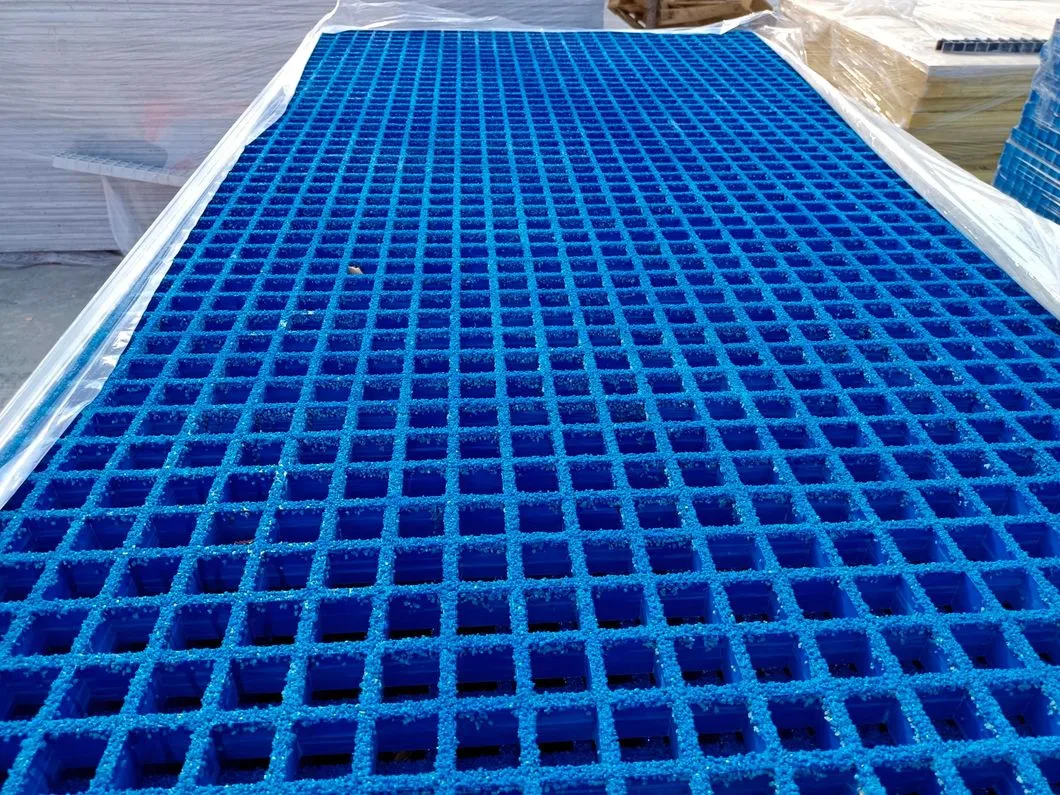Introduction
Rain‑soaked catwalks, acidic wash‑down lines, and salt‑spray platforms punish ordinary flooring until safety becomes an everyday gamble. Fiberglass reinforced plastic molded grating (often shortened to FRP molded grating) solves that problem by marrying corrosion‑proof resins with interlocking glass fibers, creating a lightweight panel that outlasts steel in hostile settings. Unicomposite, an ISO‑certified pultrusion manufacturer with its own molding and finishing lines in China, has seen demand rise 18 % year‑over‑year as utilities and OEMs trade rusted checker plate for composites that simply don’t quit.

fiberglass reinforced plastic molded grating
#1 Understanding Fiberglass Reinforced Plastic Molded Grating
#1.1 What It Is and How It’s Made
Unlike pultruded grating, which uses continuous unidirectional rovings, molded grating is produced in an open mold where glass rovings are hand‑laid in two directions and completely wetted with thermoset resin. The matrix cures into a one‑piece lattice that can be trimmed to size without unraveling. A 38 mm‑thick panel typically supports 1,500 kg/m² yet weighs only 12 kg/m²—roughly one quarter the weight of galvanized steel grate of comparable span.
#1.2 Core Properties: Corrosion Resistance, Strength‑to‑Weight, Dielectric Performance
Corrosion blocker: Vinyl‑ester or phenolic resins shrug off pH 1–14 environments, slashing repaint cycles.
High strength‑to‑weight: A bidirectional weave spreads loads, so panels deflect less and can clear wider trenches.
Non‑conductive: A surface resistivity >10¹² Ω makes FRP molded grating ideal around substations where accidental arcing is unacceptable.
“For aqueous chlorine service we specify vinyl‑ester molded panels; 10‑plus years later they still test at 95 % of original flexural strength.” —Maintenance engineer, Gulf Coast chemical plant
#2 Key Industries Benefiting from FRP Molded Grating
#2.1 Wastewater Treatment & Water Utilities
Clarifiers, aeration basins, and odor‑control towers face constant moisture and biogenic sulfide attack; FRP molded grating extends walkway life to 25 years or more with minimal upkeep.
#2.2 Chemical Processing & Offshore Platforms
Oil platforms love a deck that laughs at salt spray and can be carried up a ladder by two techs. In hydrocarbon plants, fire‑retardant additives rated ASTM E‑84 Class 1 keep insurers happy.
#2.3 Food & Beverage Facilities
USDA inspectors value the open‑grid profile that drains instantly and the silica grit top surface that delivers a Coefficient of Friction ≥ 0.65 when wet, helping processors maintain zero‑slip targets.
#2.4 Power Generation & Substations
Non‑sparking properties let crews service breakers without hot‑work permits. Utilities in five states now specify FRP molded trench covers for 35 kV yards to avoid ground‑potential rise incidents.
#3 Real‑World Case Study: Extending Service Life in a Coastal Wastewater Plant
#3.1 Problem: Rapid Corrosion of Metallic Walkways
A municipal facility 3 km from the Pacific installed galvanized steel grating in 2015; within four years, chloride pitting forced monthly patching and restricted‑access warnings.
#3.2 Solution: Switch to FRP Molded Grating from Unicomposite
Engineers chose 38 mm deep, 38 × 38 mm mesh vinyl‑ester panels with a quartz‑grit top. Unicomposite pre‑trimmed panels to match existing supports, bundling them for container delivery.
#3.3 Results: 50 % Maintenance Cost Reduction over 5 Years
Since the 2020 retrofit, inspection logs show zero structural degradation and only routine hose‑down cleaning. The city projects lifetime savings of USD 210,000 versus repainting or replacing steel every seven years.
#4 Selecting the Right FRP Molded Grating for Your Project
#4.1 Load Ratings and Panel Thickness
Pedestrian traffic: 25 mm thick, L/200 deflection ≤ 5 mm at 730 kg/m².
Forklift aisles: 50 mm thick, solid‑top cover plates, span ≤ 1 m.
#4.2 Resin Systems and Fire‑Retardant Options
| Resin | Best for | Max Temp (°C) | ASTM E‑84 Flame Spread |
|---|---|---|---|
| Isophthalic | General industrial | 100 | ≤ 115 |
| Vinyl‑ester | Chemical/food | 120 | ≤ 75 |
| Phenolic | Offshore/rail | 150 | ≤ 25 |
#4.3 Slip Resistance and OSHA Compliance
Choose a grit size that balances clean‑ability with grip. OSHA 1910.22 requires surfaces to be “kept dry or slip‑resistant”; a 60‑mesh silica broadcast is a proven middle ground for wet‑process lines.
#5 Installation and Lifecycle Considerations
#5.1 Cutting, Fabrication, and Safety Tips
Carbide‑tipped circular saws or water‑cooled diamond blades leave crisp edges. Always wear an N95 or P2 respirator; glass dust is an irritant. Stainless steel M‑clips spaced every 45 cm prevent uplift in high wind zones.
#5.2 Maintenance Best Practices to Maximize ROI
Quarterly pressure‑wash to remove biofilm.
Annual torque check on hold‑downs (target 9 N·m).
Keep de‑icing salts below 10 % sodium chloride to avoid resin bloom.
Conclusion
Composite grating delivers lighter, safer, longer‑lasting access ways across industries from sewage treatment to offshore rigs. When the specification calls for corrosion immunity and low lifetime cost, fiberglass reinforced plastic molded grating is the modern answer. Unicomposite’s engineering team can provide panel samples, technical datasheets, or design assistance for your next capital project—reach out today for a fast, no‑obligation quote.
Frequently Asked Questions
Q1. How long does FRP molded grating typically last in corrosive environments?
Most owners report a service life of 20–30 years in saltwater or chemical splash zones, provided routine cleaning and clip inspections are performed.
Q2. Can the grating be supplied in custom colors or resin formulations?
Yes. Pigments can be matched to RAL or Pantone codes, and resins can be tailored—e.g., fire‑retardant vinyl‑ester for oil & gas or food‑grade polyester for dairies.
Q3. What is the lead time for bulk orders?
Standard panel sizes (1,220 × 3,660 mm) usually ship in 2–3 weeks. Custom cut‑to‑length or covered grating may require 4–6 weeks, depending on tooling loads.
Q4. How is FRP molded grating shipped internationally?
Panels are nested and banded on fumigation‑free timber pallets, then containerized. Weight savings often lower freight costs by 30 % compared with steel.
Q5. Do I need special fasteners for installation?
Use stainless or FRP‑coated M‑ or J‑clips; carbon‑steel hardware can undermine corrosion resistance and create galvanic couples.




























